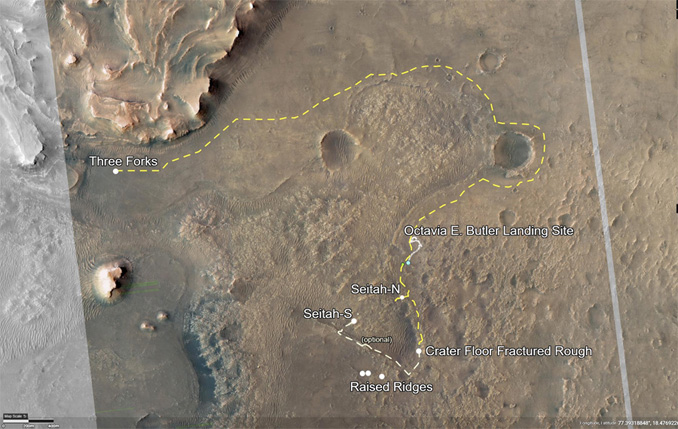
After five months of tests and checkout, NASA’s Perseverance Mars rover is poised to collect its first core sample from the floor of Jezero Crater where remnants of microbial life may have been preserved in ancient lakebed deposits.
“When Neil Armstrong took the first sample from the Sea of Tranquility 52 years ago, he began a process that would rewrite what humanity knew about the Moon,” Thomas Zurbuchen, director of science at NASA Headquarters, said in a statement.
“I have every expectation that Perseverance’s first sample from Jezero Crater, and those that come after, will do the same for Mars. We are on the threshold of a new era of planetary science and discovery.”
Perseverance landed on the floor of Jezero Crater on 18 February, just beyond a delta formation left behind by rushing water that flowed in through the rim a few billion years ago, feeding a 45-kilometre-wide (28-mile-wide) lake. Since landing, the rover has traveled due south, skirting potentially dangerous sand dunes on the way to a promising rock unit known as “cratered floor fractured rough.”
“Perhaps like a lot of you folks, we’ve actually been on a road trip,” Jennifer Trosper, Perseverance project manager at NASA’s Jet Propulsion Laboratory, told reporters during a 22 July news briefing. “This road trip is associated with our very first science campaign and during it, we will take our very first sample from the surface of Mars.”

Scientists have not yet determined whether the rocks in the immediate vicinity are sedimentary, which one might expect at the bottom of an ancient lake, or possibly volcanic in origin.
But there is little doubt Jezero was once filled with water that flowed in through canyon-like fissures in the rim and then fanned out, depositing sediments that built up a clearly defined delta.
“Probably the most surprising thing that we have seen so far is when we look at images of the delta … we see clear evidence that there was indeed a lake, there was a period when the water level was quite high,” said project scientist Ken Farley.
“But we also see higher up, and this you can only see from the ground, you can’t see it from orbit, is that higher up and therefore younger, there was a period of lower Lake levels and flooding, what might have been flash flooding, moving large boulders across the top of the delta.”
He said that suggest “multiple phases in which this lake was active. So that’s an especially interesting aspect to this environment, that it might record multiple events” suggesting “multiple time periods when we might be able to look for evidence of ancient life that might have existed on the planet.”
Perseverance is equipped with a complex sample collection and caching system that is designed to extract small core samples using an impact drill on the end of an articulating robot arm. Samples can then be loaded into an internal mechanism where they will be subjected to initial analysis, sealed in small tubes and then stored. They eventually will be deposited on the surface in one or more caches.
NASA and the European Space Agency plan to send another rover to Jezero later this decade to retrieve the samples, load them into a small rocket and launch them into orbit where yet another spacecraft will be waiting to bring them back to Earth for laboratory analysis.
Perseverance is equipped with 43 sample tubes, including five so-called “witness” tubes used to preserve any earthly contamination that might have been brought to Mars aboard the spacecraft so it can be accounted for when the samples are returned. One of those witness tubes was recently processed inside the rover to test to mechanism.
“The great news is, that all worked perfectly,” Trosper said. “And so we are ready to sample. I am very excited about getting our first sample on Mars. … We’re ready to go, and we expect to get that first sample within the first few weeks of August.”



